|
|
| |
|
 | Search: |
|
|
 |
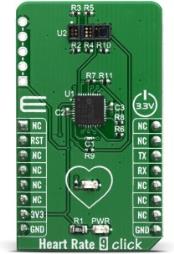
|
|
The Heart Rate 9 click is a Click board™ which features PIC16F1779 8-bit MCU and SFH 7060 heart rate and pulse oximetry monitoring sensor. This click has an algorithm for processing data from the sensor and it can send data for 3 different diodes (green, ir, red) who give out a diagram of the heartbeat and its frequency per minute. The data has shown that the most notable signal comes from the green diode because it has the best reflection through the surface of the skin due to its shortest wavelength among three light sources. Implementing a light barrier to block optical crosstalk and improved geometry for optimized signal quality. Most reflective heart rate monitors still have significant noise in their designs despite the use of complex and expensive analog circuits such as Analog Front End (AFE) chips. A more cost-effective method for reducing noise and taking these measurements is necessary.
The Heart Rate 9 click is supported by a mikroSDK compliant library, which includes functions that simplify software development. This Click board™ comes as a fully tested product, ready to be used on a system equipped with the mikroBUS™ socket.
|
|
|
|
|
 |

|
|
Heart Rate click carries Maxim's MAX30100 integrated pulse oximetry and heart-rate sensor. It's an optical sensor that derives its readings from emitting two wavelengths of light from two LEDs – a red and an infrared one – then measuring the absorbance of pulsing blood through a photodetector. This particular LED color combination is optimized for reading the data through the tip of one's finger. The signal is processed by a low-noise analog signal processing unit and communicated to the target MCU through the mikroBUS I2C interface. Developers of end-user applications should note that the readings can be negatively impacted by excess motion and changes in temperature. Also, too much pressure can constrict capillary blood flow and therefore diminish the reliability of the data. A programmable INT pin is also available. Uses 3.3V power supply. |
|
|
|
 |
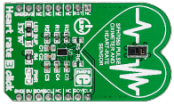
|
|
Heart rate 3 click is a mikroBUS add-on board whose functionality is determined by two components: an OSRAM’s SFH7050 pulse oximetry and heart rate monitoring module, and a TI AFE4404 (analong-front-end) IC specialized for bio-sensing.
The SFH7050 multichip package contains 3 LEDs and one photodiode separated with a light barrier to prevent optical crosstalk. When the three LEDs shine through a subject’s finger, some of the light is absorbed by the pulsating blood.
The analog reading from the SFH7050 is forwarded to the AFE chip that is able to derive pulse readings from the intensity of the reflected light.
AFE4404 is highly-configurable and adaptable for different usage scenarios (different lighting conditions or skin tones) making Heart rate 3 click a robust heart rate monitoring solution.
The board communicates with the target MCU through the mikroBUS™ I2C interface, with additional functionality provided by RST, CLK and RDY pins.
Heart rate 3 click works on a 3.3V power supply, but an onboard jumper allows you to set the voltage for driving the SFH7050 LEDs at either 3.3V or 5V. |
|
|
|
 |
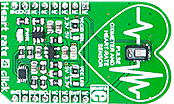
|
|
Heart rate 4 click carries the MAX30101 high-sensitivity pulse oximeter and heart-rate sensor from Maxim Integrated. The click is designed to run on either 3.3V or 5V power supply. It communicates with the target MCU over I2C interface, with additional functionality provided by INT pin on the mikroBUS™ line. |
|
|
|
 |
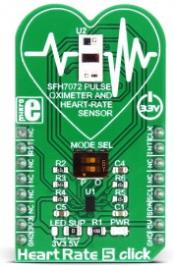
|
|
Heart Rate 5 click is the optical biosensor Click board™ which can be used for the heart-rate monitoring (HRM), as well as the peripheral capillary oxygen saturation monitoring (SpO2). This Click board™ employs a very sensitive analog front-end IC with high dynamic range, which ensures accurate and reliable readings. This analog front-end IC is coupled with the optical front end, which consists of the top-of-the-class integrated BIOFY® sensor, which features two green LEDs, one red LED, one infrared LED, and two photodiodes (PD), offering very accurate HRM and SpO2 readings. |
|
|
|
 |
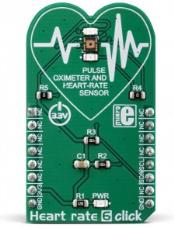
|
|
Heart rate 6 click is an optical biosensor Click board™ designed for heart-rate monitoring (HRM). This Click board™ employs a specialized sensor that incorporates two LED drivers and photo-sensing elements which are the most sensitive to green light. The green light is most commonly used to measure the dilatation of the blood vessels, therefore Heart rate 6 is equipped with two green LEDs, which are driven by the BH1790GLC, a monolithic integrated sensor for heart rate monitoring. Heart rate 6 click is a perfect solution for the development of various wearable health-related devices, smartphones, tablets, and similar space-constrained applications.
It comes in the package which also includes the mikroSDK™ software and a library with all the functions. The Click board™ comes as a fully tested and approved prototype, making it a reliable device ready to use on the development board. |
|
|
|
 |
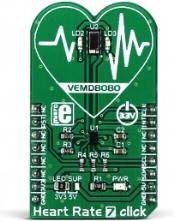
|
|
Heart Rate 7 click is an optical biosensor Click board™ which can be used for heart-rate monitoring (HRM). This Click board™ employs a very sensitive analog front-end IC with high dynamic range, which ensures accurate and reliable readings. This analog front-end IC is coupled with the optical front end, which consists of a sensitive photo-diode (PD) and two high brightness green LEDs. The photo-diode is the most sensitive to a visible light spectrum, offering reasonably high current output compared to other, standard type PD elements used so far, thus providing very accurate HRM readings. |
|
|
|
 |
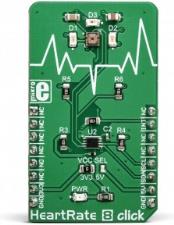
|
|
Heart Rate 8 click is an optical biosensor Click board™, designed for heart-rate monitoring (HRM). This Click board™ employs a specialized sensor that incorporates three LED drivers and two photo-sensing elements, sensitive to green and IR light. The green light is most commonly used to measure the dilatation of the blood vessels; therefore, Heart rate 8 click is equipped with two green LEDs, which are driven by the BH1792GLC, a monolithic integrated sensor for heart rate monitoring, and the additional IR LED, used to detect a finger touch. Heart rate 8 click is a perfect solution for the development of various wearable health-related devices, smart phones, tablets, and similar space-constrained applications.
It comes in the package which also includes the mikroSDK™ software and a library with all the functions. The Click board™ comes as a fully tested and approved prototype, making it a reliable device ready to use on the development board.
|
|
|
|
 |
|
|

